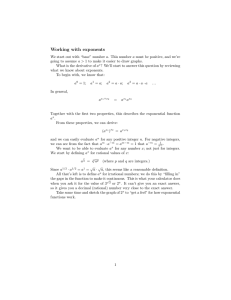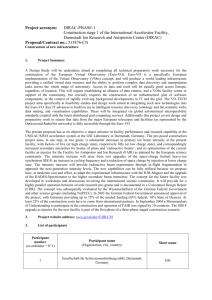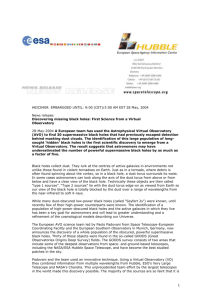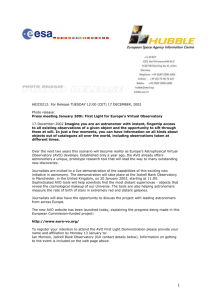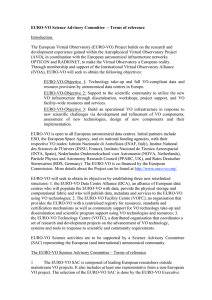The Virtual Observatory in Europe and at ESO
advertisement
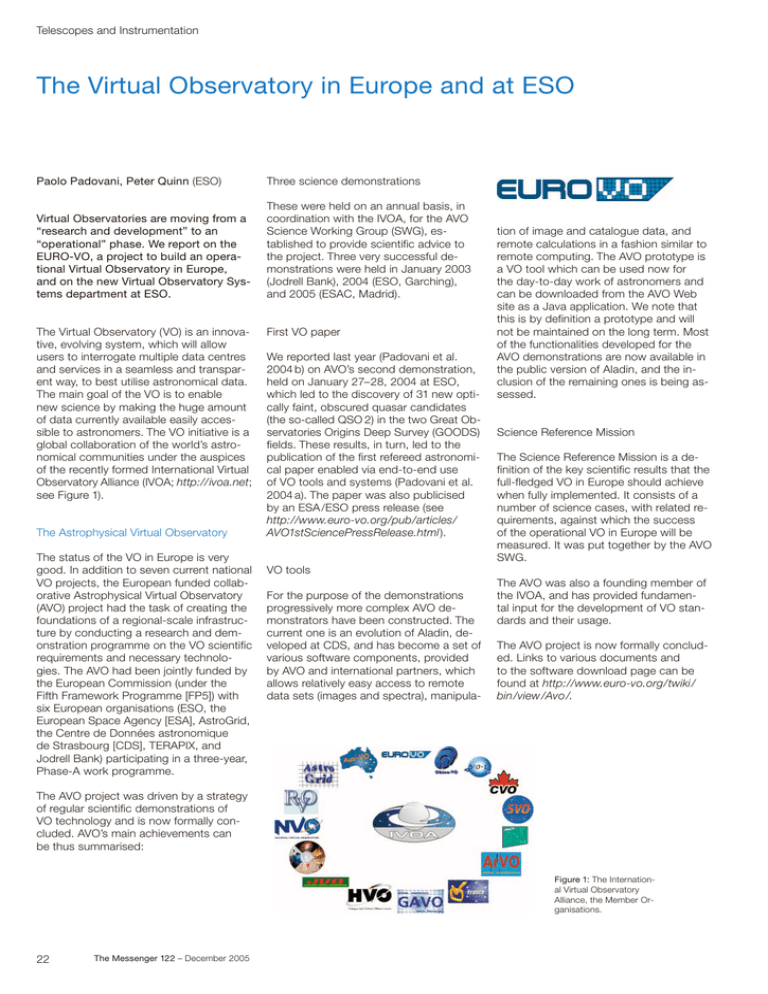
Telescopes and Instrumentation The Virtual Observatory in Europe and at ESO Paolo Padovani, Peter Quinn (ESO) Three science demonstrations Virtual Observatories are moving from a “research and development” to an “operational” phase. We report on the EURO-VO, a project to build an operational Virtual Observatory in Europe, and on the new Virtual Observatory Systems department at ESO. These were held on an annual basis, in coordination with the IVOA, for the AVO Science Working Group (SWG), established to provide scientific advice to the project. Three very successful demonstrations were held in January 2003 (Jodrell Bank), 2004 (ESO, Garching), and 2005 (ESAC, Madrid). The Virtual Observatory (VO) is an innovative, evolving system, which will allow users to interrogate multiple data centres and services in a seamless and transparent way, to best utilise astronomical data. The main goal of the VO is to enable new science by making the huge amount of data currently available easily accessible to astronomers. The VO initiative is a global collaboration of the world’s astronomical communities under the auspices of the recently formed International Virtual Observatory Alliance (IVOA; http://ivoa.net; see Figure 1). The Astrophysical Virtual Observatory The status of the VO in Europe is very good. In addition to seven current national VO projects, the European funded collaborative Astrophysical Virtual Observatory (AVO) project had the task of creating the foundations of a regional-scale infrastructure by conducting a research and demonstration programme on the VO scientific requirements and necessary technologies. The AVO had been jointly funded by the European Commission (under the Fifth Framework Programme [FP5]) with six European organisations (ESO, the European Space Agency [ESA], AstroGrid, the Centre de Données astronomique de Strasbourg [CDS], TERAPIX, and Jodrell Bank) participating in a three-year, Phase-A work programme. First VO paper We reported last year (Padovani et al. 2004 b) on AVO’s second demonstration, held on January 27–28, 2004 at ESO, which led to the discovery of 31 new optically faint, obscured quasar candidates (the so-called QSO 2) in the two Great Observatories Origins Deep Survey (GOODS) fields. These results, in turn, led to the publication of the first refereed astronomical paper enabled via end-to-end use of VO tools and systems (Padovani et al. 2004 a). The paper was also publicised by an ESA /ESO press release (see http://www.euro-vo.org/pub/articles/ AVO1stSciencePressRelease.html). tion of image and catalogue data, and remote calculations in a fashion similar to remote computing. The AVO prototype is a VO tool which can be used now for the day-to-day work of astronomers and can be downloaded from the AVO Web site as a Java application. We note that this is by definition a prototype and will not be maintained on the long term. Most of the functionalities developed for the AVO demonstrations are now available in the public version of Aladin, and the inclusion of the remaining ones is being assessed. Science Reference Mission The Science Reference Mission is a definition of the key scientific results that the full-fledged VO in Europe should achieve when fully implemented. It consists of a number of science cases, with related requirements, against which the success of the operational VO in Europe will be measured. It was put together by the AVO SWG. VO tools For the purpose of the demonstrations progressively more complex AVO demonstrators have been constructed. The current one is an evolution of Aladin, developed at CDS, and has become a set of various software components, provided by AVO and international partners, which allows relatively easy access to remote data sets (images and spectra), manipula- The AVO was also a founding member of the IVOA, and has provided fundamental input for the development of VO standards and their usage. The AVO project is now formally concluded. Links to various documents and to the software download page can be found at http://www.euro-vo.org/twiki / bin /view /Avo /. The AVO project was driven by a strategy of regular scientific demonstrations of VO technology and is now formally concluded. AVO’s main achievements can be thus summarised: Figure 1: The International Virtual Observatory Alliance, the Member Organisations. 22 The Messenger 122 – December 2005 The EURO-VO The EURO-VO work programme is the logical next step from AVO as a Phase-B deployment of an operational VO in Europe. Building on the development experience gained within the AVO Project, in coordination with the European astronomical infrastructural networks OPTICON and RADIONET, and through membership and support of the IVOA, EURO-VO will seek to obtain the following objectives: (1) technology take-up and full VO compliant data and resource provision by astronomical data centres in Europe; (2) support to the scientific community to utilise the new VO infrastructure through dissemination, workshops, project support, and VO facility-wide resources and services; (3) building of an operational VO infrastructure in response to new scientific challenges via development and refinement of VO components, assessment of new technologies, design of new components and their implementation. EUROVO is open to all European astronomical data centres. Initial partners include ESO, the European Space Agency, and six national funding agencies, with their respective VO nodes: Istituto Nazionale di Astrofisica (INAF, Italy), Institut National des Sciences de l’Univers (INSU, France), Instituto Nacional de Técnica Aeroespacial (INTA, Spain), Nederlandse Onderzoekschool voor Astronomie (NOVA, the Netherlands), Particle Physics and Astronomy Research Council (PPARC, United Kingdom), and Rat Deutscher Sternwarten (RDS, Germany). The total planned EURO-VO resources sum up to approximately 60 persons per year over three years, i.e., about three times those of the AVO. EURO-VO will seek to obtain its objectives by establishing three new interlinked structures: 1. the EURO-VO Data Centre Alliance (DCA), an alliance of European data centres who will populate the EUROVO with data, provide the physical storage and computational fabric and who will publish data, metadata and services to the EURO-VO using VO technologies; 2. the EURO-VO Facility Centre (VOFC), an organisation that provides the EUROVO with a centralised registry for resources, standards and certification mechanisms as well as community support for VO technology take-up and dissemi- nation and scientific programme support using VO technologies and resources; 3. the EURO-VO Technology Centre (VOTC), a distributed organisation that coordinates a set of research and development projects on the advancement of VO technology, systems and tools in response to scientific and community requirements. The DCA will be a persistent alliance of data centre communities represented at a national level. Through membership in the DCA, a nation’s community of data curators and data service providers will be represented in a forum that will facilitate the take-up of VO standards, share best practice for data providers, consolidate operational requirements for VO-enabled tools and systems and enable the identification and promotion of scientific requirements from programmes of strategic national interest that require VO technologies and services. Funds for the DCA have been requested in an FP6 proposal submitted in September 2005. The VOFC will provide a “public face” to the EURO-VO. Through outreach, support of VO-enabled science projects in the community, workshops and schools, the VOFC will represent a central support structure to facilitate the broad take-up of VO tools by the community. The VOFC will also support the EURO-VO Science Advisory Committee (SAC) to ensure appropriate and effective scientific guidance from the community of leading researchers outside the mainstream VO projects. The SAC will provide an up-to-date stream of high-level science requirements to the EURO-VO. The VOFC will further provide central services to the DCA for resource registry, metadata standards and EUROVO access. Funding for the VOFC has yet to be fully defined but will come initially from ESO and ESA with activities ramping up in 2006. The first VOFC activity was the organisation of the EURO-VO workshop at ESO Headquarters in Garching from June 27 to July 1, 2005 (Padovani & Dolensky 2005). The VOTC will consist of a series of coordinated technology research and development projects conducted in a distributed manner across the member organisations. The first project under the VOTC is the VO-TECH project, funded through the EC FP6 Proposal and contributions from the Universities of Edinburgh, Leicester, and Cambridge in the United Kingdom, ESO, CNRS and Université Louis Pasteur (France), and INAF (Italy). Additional projects can be brought to the VOTC via other member organisations; one such example is ESA-VO. The VOTC provides a mechanism to coordinate and share technological developments, a channel for DCA and VOFC requirements to be addressed and for technological developments to be distributed to the community of data centres and individual scientists in a coordinated and effective manner. The EURO-VO project will be proactive in reaching out to European astronomers. As a first step, the EURO-VO has started making regular appearances at Joint European and National Astronomy Meetings (JENAM), as of the one in Liège in July 2005. VO and ESO Data centres have a major role in the VO, as they are the primary source of astronomical data. The VO cannot (and does not) dictate how a data centre handles its own archive. However, a “VO-layer” is needed to “translate” any locally defined parameter to the standard (i.e., IVOA compliant) ones. For example, right ascension can be defined in different ways by different data centres but the VO user needs to know which of the many parameters accessible through an archive interface is the right ascension. The longerterm vision of the VO is also to hide away any observatory/telescope/instrument specific detail and work in astronomical units, for example, “wavelength range” and not grism or filter name. Data providers are then advised to systematically collect metadata (“data about data”) about the curation process, assign unique identifiers, describe the general content (e.g., physical coverage) of a collection, and provide interface and capability parameters of public services. Finally, the VO will work at its best with high-level or “science-grade” data, so that the VO user is spared as much as possible any complex and time-consuming data reduction. Data centres should then make an effort to provide such data. The Messenger 122 – December 2005 23 Telescopes and Instrumentation Padovani P., Quinn P., The Virtual Observatory in Europe and at ESO All these issues obviously affect ESO as well. To address them, the Data Management and Operations Division created the Virtual Observatory Systems (VOS) Department on November 1, 2004. VOS’ role is to manage ESOs involvement in VO activities and to make the Science Archive Facility (SAF) into a powerful scientific resource for the ESO community. The new department, headed by Paolo Padovani, includes, at present, the Virtual Observatory Technology (VOT) and the Advanced Data Products (ADP) groups, led respectively by Markus Dolensky and Piero Rosati, and is made up of thirteen people. (VST; Cappellaro 2005; Capaccioli et al. 2005) and from VISTA (Emerson et al. 2004); 3. Publication of ADP within the VO infrastructure; this will require a complete redesign of the SAF and of its interface. As a first step in that direction, on the occasion of the opening of the ESO archive to the world on April 4, 2005, VOS has deployed a redesigned archive interface. Its aim is to facilitate data queries to archival users who might not be familiar with ESO instruments. The new interface is accessible at http://archive.eso.org/eso/ eso_archive_main.html; 4. Development of VO technology, standards, and tools for the ESO SAF, also via participation to European VO activities, in particular through the VOTech project. References Capaccioli, M., Mancini, D., Sedmak, G. 2005, The Messenger 120, 10 Cappellaro, E. 2005, The Messenger 120, 13 Emerson, J. P. et al. 2005, The Messenger 117, 26 Padovani, P. et al. 2004a, A&A 424, 545 Padovani, P. et al. 2004b, The Messenger 117, 58 Padovani, P., Dolensky, M. 2005, The Messenger 121, 60 The specific tasks of VOS are the following: 1. Creation of ADP, i.e., science-ready (“level-3” in ESO terms) data products from the ESO archive; this will be done by using a redesigned imaging pipeline built on top of the EIS/MVM software and also via a coordinated activity between the ADP and the Data Flow System (DFS) groups to single out possible upgrades of specific DFS pipelines from level-2 to level-3. A recent ADP effort has been the processing via the EIS/MVM software and release of the ISAAC/GOODS data, which include 11600 science frames and 10 600 calibration frames, photometrically calibrated using pre-determined zero points from SOFI data. These data are available at http://www.eso.org/science/ goods/releases/20050930/ (see Figure 2); 2. Ingestion of ADP into a VO-compliant SAF; these will include not only products generated by the ADP group but also by the community. For example, scienceready data products from a number of ESO projects, which are currently available in a heterogeneous fashion from customised web pages. In particular, as of Period 75 PIs of Large Programmes are requested to provide ESO with their reduced data products at the time of publication of their results. Moreover, Public Survey data products will also be ingested and published in a VO-compliant way, as they will be extremely useful to VO users, being highly homogeneous and well calibrated. These will include data from OmegaCAM on the VLT Survey Telescope 24 The Messenger 122 – December 2005 Figure 2: JHK colour composite of the ISAAC/GOODS mosaic part of the latest Advanced Data Products group of the Virtual Observatory Systems (VOS) Department release, which includes 21 tiles in the J-, Hand Ks-bands, and five additional tiles in the J- and Ks-bands (not visible in this image). Each ISAAC field is 2.5 arcmin across. See http://www.eso.org/ science/goods/releases/20050930/

